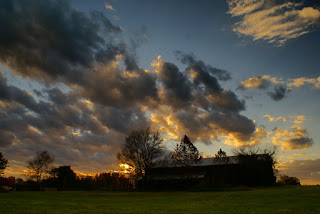The main difference between Ansel Adams...and most of us...is that he looked at photography from an artistic perspective...he experimented...tried different techniques...he never settled for ordinary...and he understood the capabilities of his camera equipment.
Camera's really are not all that smart. In spite of the sophisticated electronics and the built in auto exposure capabilities, they still only read the light in such a way as to make a best guess calculation and move the exposure to the middle of the scale. If all you are wanting to accomplish is to take snapshots and capture simple pictures with very little artistic merit, then the auto exposure works pretty well. It's been a great marketing ploy for the camera manufacturers...making it easy to take decent photo's without thinking to hard.
But, when it comes to capturing images with artistic merit...well...now that requires a bit more...let's say... understanding of what the camera is actually doing. I don't have room here to go into a long explanation of all the functions of digital camera's. But, what I'm going to do is give you an example of the difference between what happens when you simply allow the camera to do what it wants to do...and you telling the camera to do what you want it to do.
Most of my photography involves nature and/or landscape photography. As a result, I tend to shoot almost exclusively in Aperture Priority...that is where you select the aperture or f/stop and the camera selects a corresponding shutter speed. Aperture priority allows me to control the depth-of-field which is important in landscape photography. I also use a lot of exposure compensation...you know...that little +/- button usually on the back or maybe the top of your camera...anyway...I rarely shoot in full manual mode.

Another aspect of digital cameras is how white balance affects the image, or how well the camera captures color depending on the temperature of the light. (Indoor lighting has a different temperature range than daytime outdoor light). Most digital camera's allow you to change the white balance, but I would guess most people simply use the auto white balance (AWB) setting and just let the camera make that choice for them. White balance can also be adjusted by using the group or symbol settings...like shade, or cloudy, or portrait...these actually help quite a bit and are easy to use.
AWB works pretty well within a set range of light temperatures. If the light on your subject falls outside that range, then AWB will often shift the color either toward the blueish or reddish side depending on the light temperature situation. Knowing and using this to your advantage can have a huge impact on how your images turn out.
Here's an example. This first image above was taken simply allowing the camera to do what it wanted to do. It's not a terrible picture...but right away you may notice that it seems to have a rather bluish tint to it. That's because the light temperature at the time fell well outside the normal range of the AWB capabilities. What I was experiencing visually and emotionally was a deeper, richer lighting situation...So, how then did I manage to capture the next image taken just a few minutes later?

Both images come straight out of the camera...no Photoshop tweaking was done to either of them. The bottom image is a much more powerful image...richer...deeper...more dramatic in its texture and overall effect. Well, basically there is only one camera setting difference between the two images. Instead of using AWB, or either of the Shade or Cloudy setting on the camera...I switched over to manual White Balance and shifted the setting from it's normal middle of the road 5500 degrees kelvin to 9900 degrees kelvin. That simple shift told the camera to push the color setting from a middle temperature range to a range that more closely matched the color temperature of the sky at the time. Doing so caused the camera to capture the scene in a much bolder rendition.
The reason I am explaining all this is to re-enforce the idea that photography is not always about capturing exactly what you see.
It's about capturing what you feel. Understanding how the camera reacts to light is one of the first advanced concepts that novice photographers should understand. Doing so gives you a tremendous advantage when it comes telling the camera to do what you want it to do...instead of simply accepting what the camera wants to give you.
Here's another example. This next image is one where I basically allowed the camera to do what it wanted to do...I did use a graduated filter to darken the sky some and tweaked the brightness a bit in Photoshop, otherwise it is pretty much the way it looked coming out of the camera and represents the scene very closely to what it actually looked like.
Overall...it's not a bad image with some interesting cloud features. But, looking at it tells me one thing.
I've seen this kind of image a thousand times...I've taken this kind of image a thousand times. Other than the unique cloud formations there really isn't anything extraordinary about this image. But, remember...photography is not about what you see...it's about what you feel. So...knowing this I wanted to capture the scene in a different way... a way that would generate more drama...more power...more depth and impact. So...I shifted my location to gain a more dramatic composition and...once again...I shifted the WB to manual...and pushed the setting from 5500 to 9900...here is the result.
Same lighting...same basic scene...Big difference. Which one portrays more drama...which one looks ordinary? Did the scene actually look like this?...not really...but that is the way I wanted it to appear...that is what I was feeling...what I visualized the moment should be and could be.
Understanding that what the camera sees is not necessarily what you see is one of the most difficult concepts for novice photographers to grasp. Understanding this...combined with a solid working knowledge of the mechanics of your camera...can result in creating amazingly bold and powerful images even under rather ordinary circumstances. It's also important to remember that you don't have to settle for what the camera wants to give you...in most cases what it offers is simply an average...and we as photographers should never settle for average.
Keith














